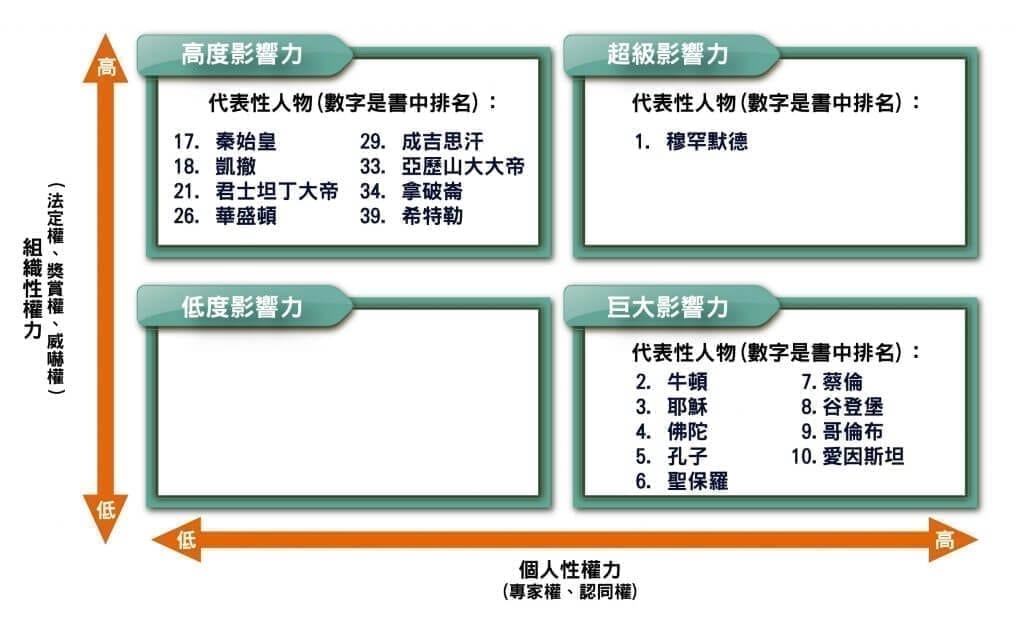
Author: Associate Professor, Institute of Human Resource Management, Chung-Ang University/Lin Wenzheng
I often use the past as a metaphor for the present to point out that modern business executives should learn from historical figures about leadership and wisdom, so which figures are exemplary? I would like to borrow a book to answer this simple but difficult question. "The 100 Most Influential People in History" is an easy-to-read and enlightening book in which the author selects the 100 most influential people from all types of historical figures in the world according to his personal opinion. The top 10 of the book, as well as the more familiar historical figures in the top 50, I have listed some of them and categorized them in the table below, and the following categories are only my personal opinion.
The horizontal and vertical axes of the table below are individual power (i.e., expert power and recognition power) and organizational power (i.e., legal power, reward power, and intimidation power), respectively, according to the research of French & Raven (1959), there are five sources of power:
- Legal power: The power to direct others through titles based on laws, norms, beliefs, or values.
- Reward: The power to control and allocate resources, such as giving promotions, salary adjustments, bonuses, etc.
- The right to intimidate: the power to achieve an end through the creation of a sense of fear, such as demerits, scolding, not giving promotions, etc.
- Expert: The ability to influence others through one's knowledge or talent.
- Right to Identity: A person's personality, values, traits, or goals that others identify with and desire to emulate.
In Figure 1, I think only Muhammad is ranked 1st in the upper right corner (with super influence), while those ranked 2-10 are concentrated in the lower right corner (with great influence), and the kings, presidents and politicians between 17 and 39 are concentrated in the upper left corner (with high influence). And why was Muhammad so influential? Because he had both organizational and personal power, he had the prestige of a political leader (the king of Arabia) and the prestige of a religious leader (the founder of Islam).

In addition, why are Newton, Confucius, St. Paul, Cai Lun, Gutenberg, Columbus, and Einstein, as well as Jesus and Shakyamuni, who have "the right to identify", more influential than kings such as Qin Shi Huang and Genghis Khan? It is passive in that the basis of power derives from titles, but titles are often susceptible to organizational and environmental influences, and when an individual loses his title, organizational power usually disappears at the same time.
Five Indicators of Authority to Examine Your "Power Base"
Based on the analysis of the influence of the above-mentioned historical figures, a scale that measures the five types of power of individuals is quoted here, and individuals can evaluate their self-perception of power.
Below is a five-part scale (1 = strongly disagree; 2 = disagree; 3 = somewhat agree; 4 = agree; 5 = strongly agree. )

Source: Dieterly, D.L., & Schneider, B. (1974). The effect of organizational environment on perceived power and climate. A laboratory study. Organizational Behavior and Human Performance, 11, 316-337.
Below is a description of the scores for each of the five power bases, which can explain the strength of your personal five power bases.
3-6 = Weak power base
7-11 = Moderate power base
12-15 = High power base
Influence Nine Square Grid – How Much Influence Do I Have?
According to Dieterly, & Schneider (1974), I divide organizational (45 out of total) and personal (30 out of 30) power into three levels: high, middle, and low, resulting in the following nine squares of influence (see Figure 2).

If the score is 1, 2, 3 squares, it can be called like a fish in water;
A score of 4, 5, or 6 can be called a thin ice zone;
The score of 7, 8, 9 can be called the pins and needles area.
Many people wonder why Muhammad's influence is at the top of history, because he has both formidable authority and beloved prestige. If someone asks, when authoritarianism and prestige cannot be combined, how do we choose? Personally, I believe that wise leaders should prioritize prestige over authority.
About the Author:
Associate Professor, Institute of Human Resource Management, Chung-Ang University/Lin Wenzheng

He is currently an associate professor at the Institute of Human Resource Management and the CEO of EMBA at Chung-Ang University. He used to have a Ph.D. in Industrial Relations and Human Resource Management from Michigan State University, the director of the Institute of Human Resource Management at National Central University, the vice chairman of the Chinese Human Resource Management Association, the director of the Chinese Human Resources Development Association, the member of the Taoyuan County Labor Dispute Arbitration Committee, and the labor standards member of the Labor Commission of the Executive Yuan. His areas of expertise include international human resource management, payroll, training and development, team building and leadership, and talent management.

Related Books: "The First Things to Know When a Supervisor Matters"

You must be logged in to post a comment.